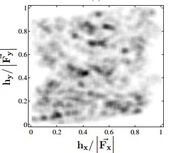Highlight
How does dry sand become rigid?
Achievement/Results
Dr. Dapeng Bi, Prof. Bulbul Chakraborty, and Sumantra Sarkar at Brandeis, together with Prof. Robert Behringer at Duke and Dr. Jie Zhang at Shanghai Jiao Tong University, have developed a novel framework to explain how dry sand can act like a solid when it is sheared. “Granular materials” include sand, agricultural grains, pharmaceutical products, and rocks making up asteroids; their properties when packed, shaken, or transported have important implications for basic scientific questions and industrial applications. When subjected to shear stress — force applied across the edge of a pile of sand — they “freeze up” and resist motion as a solid, a phenomenon known as “jamming”. (This is in contrast to a liquid, in which shear stress such as wind across the water simply causes the liquid at the surface to flow). However, standard physical principles used to describe the properties of solids under stress are not applicable to jammed granular systems. In particular, the rigidity of solids arises from the emergence of a stable, non-uniform configuration of atoms such as a crystal, due to the attractive interaction between the atoms. In dry sand, the grains interact only through repulsive contact forces. Prof. Chakraborty is a co-Principal Investigator of, and Dr. Bi a former trainee in, the NSF Integrative Graduate Education and Research Traineeship (IGERT) “Geometry and Dynamics” grant at Brandeis, which covers theoretical activities in mathematics, neuroscience, economics chemistry, physics, and computer science.
As a result of the interdisciplinary interactions and activities generated by this program, Dr. Bi (then an IGERT trainee) and collaborators were able to borrow concepts at the intersection of quantum information theory and quantum condensed matter physics to develop a new theory of shear jamming in the non-quantum mechanical context of granular systems, specifically for granular systems in two dimensions. In this theory, a stable non-uniform structure develops in a more abstract space built from the distribution of forces acting on each grain. This network is shown on the right-hand side of the first figure. The nonuniformity is found in experimental observations of granular materials jammed under shear stress, and a realization of this is shown in the second figure. This structure is analogous to the signature of low-temperature phases of quantum systems that have a property known as “topological order”. This latter property arises from quantum entanglement, and is potentially useful for designing quantum computers in a way that reduces the frequency of computational error.
Address Goals
This activity developed new tools, and borrowed from disparate areas of science, to provide a descriptive framework for a phenomenon of significant fundamental and practical importance: the onset of rigidity of a granular system under sheer stress. The identification of shear jamming with structures in the space of forces opens the way for significant further progress, to explain precisely how the non-uniform structures emerge in specific systems. Furthermore, the IGERT grant and this project in particular has provided excellent training for Brandeis graduate students, combining deep theoretical and mathematical insights, interdisciplinary modes of thinking, and direct contact with experimental data.







